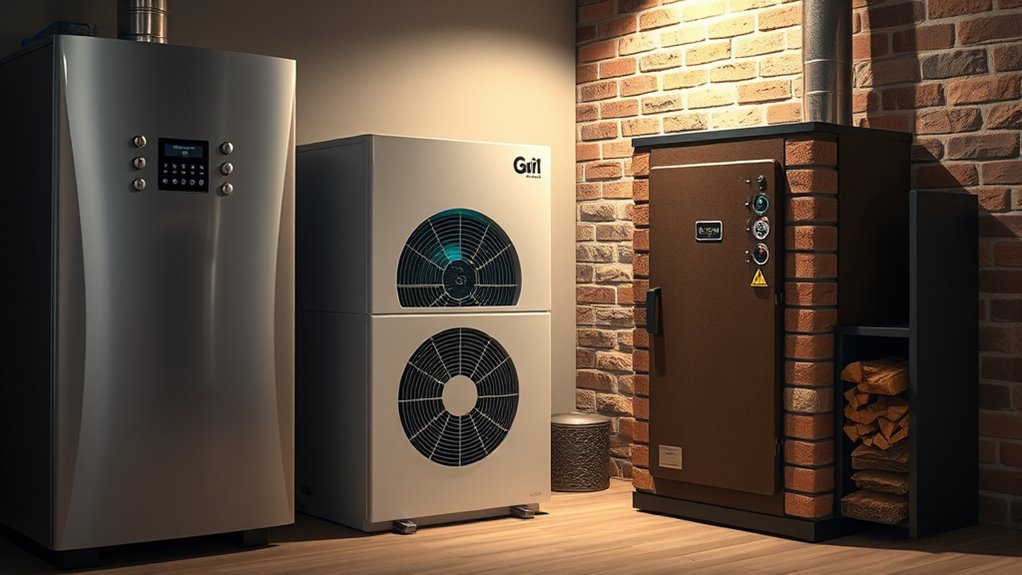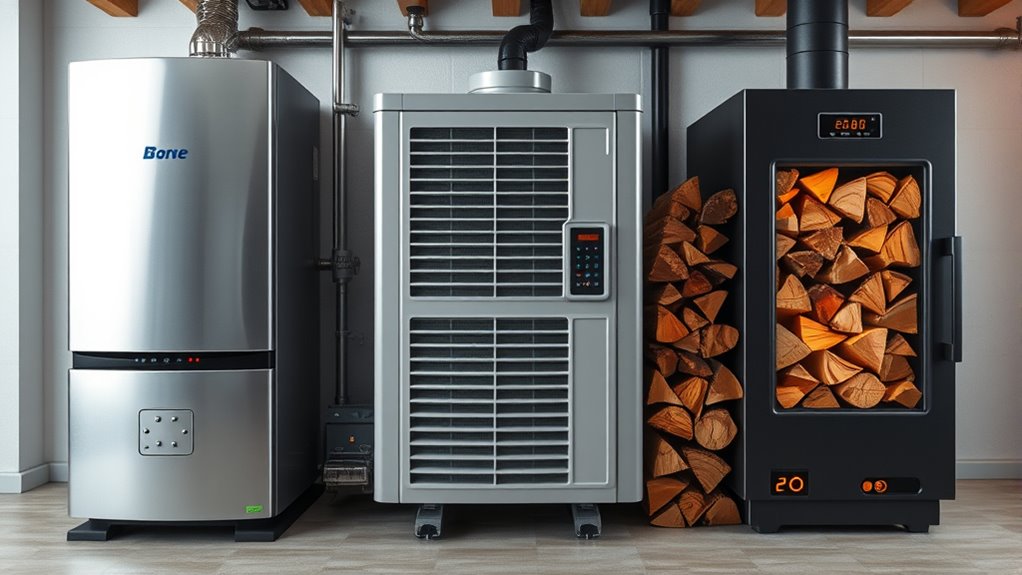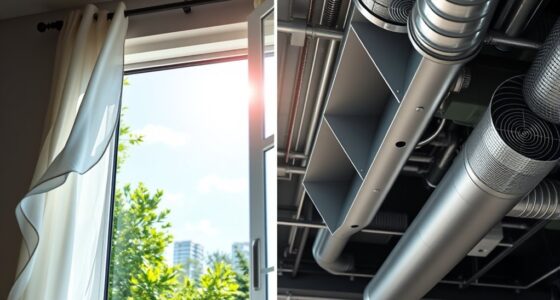Choosing between boilers, heat pumps, and biomass depends on your home’s needs and energy goals. Boilers are reliable and work well with radiators, while heat pumps offer high efficiency, especially in milder climates, but may require larger radiators. Biomass systems use renewable fuel sources and can be integrated with existing setups. Each option has benefits and considerations; exploring how radiator design complements these systems can help you maximize comfort and savings.
Key Takeaways
- Boilers provide reliable, consistent heating using gas, oil, or electricity, suitable for traditional radiators.
- Heat pumps extract environmental heat, offering high efficiency but requiring larger radiators for optimal performance.
- Biomass systems burn organic fuels like wood pellets, compatible with existing radiators or underfloor heating for renewable energy use.
- Proper radiator sizing and placement are essential for all systems to ensure even, efficient heat distribution.
- Selecting the right system depends on home layout, energy priorities, and resource availability for optimal comfort and efficiency.

Are you exploring the best ways to keep your home warm this winter? If so, it’s essential to understand the different heating options available, including boilers, heat pumps, and biomass systems. Each has its strengths and considerations, but starting with the right choice depends on your home’s needs and your energy goals. For example, if you’re interested in eco-friendly solutions, solar thermal systems can be a game-changer. They use sunlight to generate heat, reducing reliance on traditional fuels. When paired with well-designed radiator systems, solar thermal can efficiently distribute warmth throughout your home. The key is ensuring your radiator design maximizes heat transfer, with appropriately sized radiators and optimal placement, so you get the most out of your solar thermal setup without wasting energy.
Boilers remain a popular choice for many homeowners because they’re reliable and versatile. Modern boilers can operate on gas, oil, or even electricity, providing consistent heat during winter months. They work by heating water, which then circulates through radiators or underfloor heating systems. You have options here—combi boilers, system boilers, or conventional models—depending on your household size and plumbing setup. When choosing a boiler, consider how it integrates with your existing radiator design. Larger radiators or additional units may be necessary to ensure even heat distribution, especially in older homes with less efficient insulation. Proper radiator placement and sizing are crucial; an inefficient radiator layout can lead to cold spots or higher energy bills, undermining your comfort and savings.
Heat pumps offer a highly efficient alternative, especially in milder climates or where renewable energy is a priority. They work by extracting heat from the outside air or ground, then amplifying it to warm your home. While they require an initial investment, their low operating costs can pay off over time. Pairing a heat pump with a well-thought-out radiator design is vital. Since heat pumps typically operate at lower temperatures, your radiators should be larger or designed to maximize surface area, ensuring your home heats evenly and efficiently. This approach prevents cold rooms and uneven heat distribution, making your living space more comfortable.
Biomass heating, which uses organic materials like wood pellets, offers a renewable and cost-effective option, especially if you have access to sustainable fuel sources. These systems can be integrated with your existing radiator setup or underfloor heating. Like with other systems, the radiator design plays a role in how effectively the heat is dispersed. Larger radiators or improved placement help ensure the warmth from biomass systems reaches all corners of your home. Additionally, advancements in radiator design and control systems can enhance energy efficiency and user comfort.
Ultimately, choosing the right heating method depends on your priorities and home layout. Whether you opt for solar thermal with an optimized radiator design, a modern boiler, or a renewable heat pump or biomass system, focus on how your radiator setup complements your chosen technology. Well-designed radiators and proper placement are key to maximizing efficiency, comfort, and energy savings throughout the winter season.
Frequently Asked Questions
Which Heating System Is Most Environmentally Sustainable?
You should choose a heat pump for the most environmentally sustainable option. Heat pumps use renewable energy from the air, ground, or water, considerably reducing your carbon footprint. They’re highly efficient and produce fewer emissions compared to traditional boilers or biomass systems. By opting for a heat pump, you help lower greenhouse gases and support cleaner energy solutions, making it the best choice for eco-conscious heating.
How Much Does Installation Typically Cost for Each Option?
Think of installation costs as planting seeds for your home’s future warmth. Boilers typically require $3,000 to $8,000 upfront expenses, like laying a solid foundation. Heat pumps might cost $4,000 to $10,000, akin to planting a versatile tree. Biomass systems can range from $5,000 to $15,000, resembling nurturing a renewable garden. Your choice depends on your budget and sustainability goals, shaping your home’s cozy landscape for years to come.
Are There Government Incentives for Renewable Heating Solutions?
Yes, you can benefit from government grants and tax incentives for renewable heating solutions. These programs aim to reduce your upfront costs and encourage energy efficiency. Check with local authorities or energy agencies to find current offers tailored to your region. By taking advantage of these incentives, you’ll lower your overall expenses and make eco-friendly choices more affordable. Stay informed about new programs to maximize your savings and environmental impact.
How Do Operating Costs Compare Over Time?
You’ll find that operating costs vary based on the system’s efficiency and your local energy prices. Conducting a thorough cost analysis helps you compare long-term expenses, revealing that heat pumps often have lower ongoing costs due to higher efficiency. Biomass and boilers might have higher fuel or maintenance costs over time, but incentives can offset initial investments. Overall, efficiency comparison shows heat pumps generally save you money in the long run.
What Maintenance Is Required for Each Heating System?
Maintenance might seem mundane, but it’s essential for your system’s longevity and performance. Boilers demand diligent drainings and inspections, heat pumps require regular filter changes and refrigerant checks, and biomass systems need consistent ash removal and fuel inspections. The maintenance frequency varies, but staying proactive keeps systems running smoothly, prevents costly repairs, and prolongs their lifespan. Remember, regular upkeep ensures reliable warmth and efficiency year-round.
Conclusion
When choosing your heating option, think of it like picking the right tool for a job—you want efficiency, sustainability, and comfort. Boilers, heat pumps, and biomass each have their perks, so consider your home’s needs and your environmental goals. Just like a well-tuned instrument creates beautiful music, the right system will keep your home warm and cozy. Take your time, weigh your options, and you’ll find the perfect fit for a warm, eco-friendly home.










